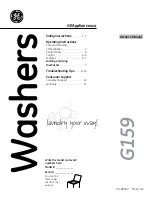
1800 PSI Pressure Washer
5
IMPORTANT: Read entire owner’s manual before you
attempt to assemble or operate your new pressure washer.
REMOVE PRESSURE
WASHER FROM
CARTON
• Slice two corners at the end of carton from top to
bottom so the panel can be folded down flat.
• Remove the parts bag, accessories, and insert included
with pressure washer.
• Roll the pressure washer out the open end of the
carton.
• Raise guide handle, secure in place (Figure 1).
• Check carton for additional loose parts.
Carton Contents
Items in the carton include:
•
Main Unit
•
Goggles
•
High Pressure Hose
•
Spray Gun
•
Nozzle Extension
•
Oil Bottle
•
Parts Bag (which includes the following):
•
Maintenance Kit
•
Owner’s Manual
•
Engine Manual
PREPARING PRESSURE
WASHER FOR USE
To prepare your pressure washer for operation, you
will need to perform these tasks:
• Add oil to engine crankcase.
• Add fuel to fuel tank.
• Connect high pressure hose to spray gun and pump.
• Connect water supply to pump.
Add Engine Oil
IMPORTANT: Any attempt to crank or start the engine
before it has been properly serviced with the
recommended oil may result in an engine failure.
• Place pressure washer on a level surface.
• Refer to the engine owners manual to add recommended
oil to engine.
NOTE: Check oil often during engine break–in. Refer to
engine owner’s manual for recommendations.
Add Gasoline
WARNING!
Never fill fuel tank indoors. Never
fill fuel tank when engine is running or hot.Allow unit
to cool for two minutes before refueling. Do Not
light a cigarette or smoke when filling the fuel tank.
WARNING!
Do Not overfill the fuel tank.
Always allow room for fuel expansion.
•
Use fresh, clean unleaded automotive gasoline
and store in
approved, clean, covered containers. Use clean fill funnels.
Never use “stale” gasoline left over from last season or
gasoline stored for long periods.
• Clean area around fuel fill cap, remove cap.
• Slowly add "UNLEADED" regular gasoline to fuel tank.
Use a funnel to prevent spillage. Slowly fill tank to about
1.5" below the bottom of the filler neck (Figure 2).
Lift the handle to upright
position and slide the
locking caps into place.
Figure 1 — Secure Handle
Figure 2 — Typical Fuel Expansion Space
Fuel
Tank
1.5” Airspace


































